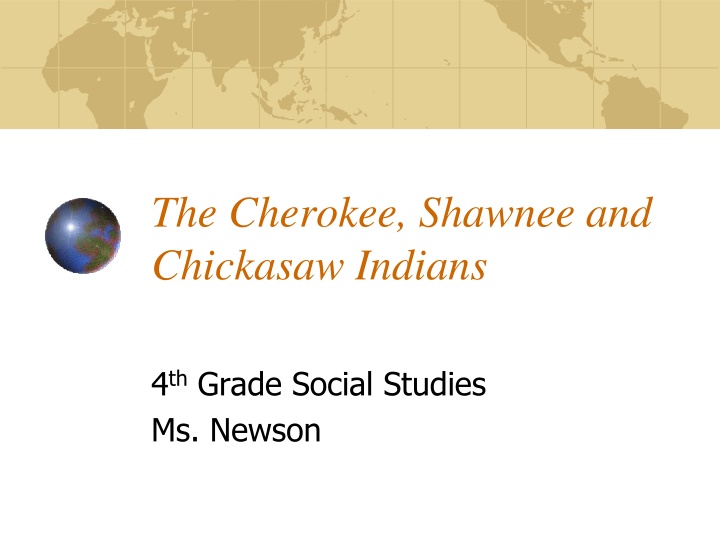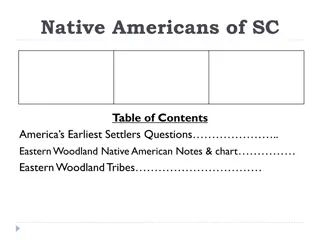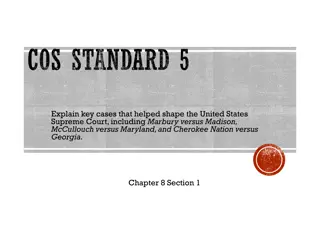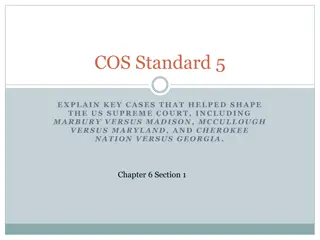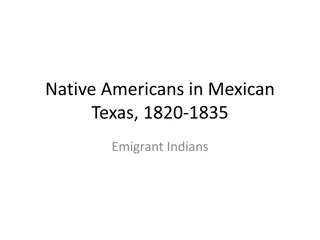Learning About Cherokee, Shawnee, and Chickasaw Indians
Delve into the history and culture of the Cherokee, Shawnee, and Chickasaw Indians through this educational material focusing on their lifestyles, beliefs, and interactions with European settlers. Explore the unique characteristics of each tribe and how they faced challenges and changes over time, shedding light on their resilience and traditions.
Download Presentation

Please find below an Image/Link to download the presentation.
The content on the website is provided AS IS for your information and personal use only. It may not be sold, licensed, or shared on other websites without obtaining consent from the author.If you encounter any issues during the download, it is possible that the publisher has removed the file from their server.
You are allowed to download the files provided on this website for personal or commercial use, subject to the condition that they are used lawfully. All files are the property of their respective owners.
The content on the website is provided AS IS for your information and personal use only. It may not be sold, licensed, or shared on other websites without obtaining consent from the author.
E N D
Presentation Transcript
The Cherokee, Shawnee and Chickasaw Indians 4thGrade Social Studies Ms. Newson
Standards 4.1.01 Understand the diversity of human cultures. a. Describe cultures of Native American tribes. 4.1.spi.4 examine how Native American culture changed as a result of contact with European cultures. (i.e. decreased population, spread of disease, increased conflict, loss of territory, increase of trade.) 4.1.spi.5. identify various racial and ethnic groups in Tennessee at the founding of statehood (i.e. Cherokee, Creek, Shawnee, English, Scottish, French, American born pioneers).
Objective Students will identify similarities and differences among the Cherokee, Chickasaw, and Shawnee Indians.
Directions Click the button to move forward from slide to slide in order. Click the button to move to the previous slide. Selecting an Indian tribe along the bottom of the screen will move you to a specific section of the tour. Vocabulary words are highlighted for you. Selecting them will guide you to the glossary. Cherokee Cherokee Shawnee Chickasaw
The Cherokee Indians A typical Cherokee village would be home to around 30 to 50 families. The Cherokee Indians - YouTube - Windows Internet Explorer The women were responsible for the house, farming, and the family. The men were responsible for hunting and war. The Cherokee were a religious people who believed in spirits. They performed ceremonies in order to ask the spirits to help them. In 1835 some of the Cherokee signed a treaty with the United States giving the US all of the Cherokee land in return for land in Oklahoma plus $5 million. Most of the Cherokee did not want to do this, but they had no choice. In 1838 the US army forced the Cherokee nation to move from their homes in the Southeast all the way to the state of Oklahoma. Over 4,000 Cherokee people died on the march to Oklahoma. Today this forced march is called the "The Trail of Tears". Cherokee Cherokee
The Shawnee Indians Because of their nomadic nature, their homes were never permanent structures. They lived in temporary dome- shaped homes called wigwams which were constructed of tree bark and sap, brush, cattails and sometimes hide. The Shawnee Indians - YouTube - Windows Internet Explorer Although they did not always get along, the Cherokee Indians to the south were very important to the Shawnee. The Shawnee adopted a lot of music and dance from them and regularly traded with them. In the early 1800s, disease and war brought the Shawnee population of over 10,000 tribe members to a mere 3,500. The Shawnee women were farmers. They grew squash, beans and several varieties of corn on the land around their homes. Women spent a lot of time doing arts and crafts. They are known for their beautiful woodcarvings, pottery and beadwork. The Shawnee men were responsible for going to war when necessary, mainly as a means of protecting their family. Shawnee
The Chickasaw Indians The Chickasaw were both farmers and hunters. They farmed the three main crops grown by many Native Americans including corn, beans, and squash. They also hunted game like deer and fished in the lakes and rivers. Chickasaw Indian Project - YouTube - Windows Internet Explorer When the United States passed the Indian Removal Act of 1830, the Chickasaw were forced to relocate to Indian Territory in Oklahoma. Other Indian nations from the southeast were also required to relocate including the Cherokee, Creek, Seminole, and Choctaw. The path they traveled has become known as the Trail of Tears. The Chickasaw Indians originally lived in the Southeast in areas of Mississippi, Alabama, Tennessee, and Kentucky. In 1832 they migrated to Oklahoma after being forced to sell their land to the United States government. The original Chickasaw Indians lived in small villages. Their homes were one room wattle and daub homes made with a wood frame covered with a plaster of mud and straw.
Glossary Allies - to join (yourself) with another person, group, etc., in order to get or give support Migrate to move from one country or place to live or work in another Nomadic - roaming about from place to place aimlessly, frequently, or without a fixed pattern of movement Reservation - an area of land in the U.S. that is kept separate as a place for Native Americans to live Territory - an area of land that belongs to or is controlled by a government Treaty - an official agreement that is made between two or more countries or groups
